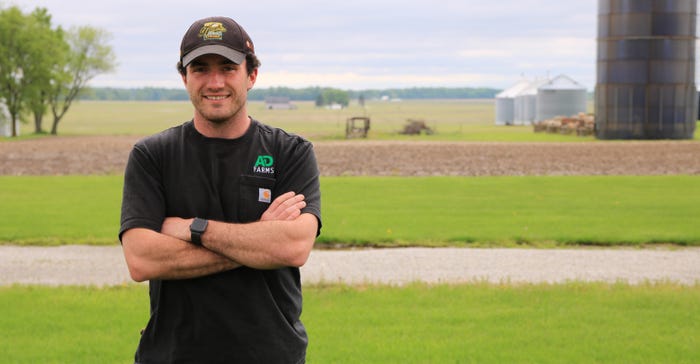
Deciding when to plant, along with deciding when to replant, is a tough call in a new normal for Illinois growers. Many are facing more extreme wet conditions in the spring, like in 2019 and 2020, and fewer moderate springs like 2018.
Andy Dole started planting this year in early April, when soil moisture was ideal. While many local farmers waited for warmer temperatures, Andy and his father, Marty Dole, say the data on their farm indicates it’s better to plant when field conditions are ideal in April than to wait for potentially suboptimal conditions in May — or even June, as was the case in 2019.
2020 appeared to be heading that way, too. “We were trending toward a wetter pattern as we got further into April. With conditions being considerably drier than they have been in previous years, we took advantage of the phenomenal planting opportunity in early April — but then this weather crept back in as we approached May,” Andy says, pointing to overcast skies above their farm. Two and a half inches of rain came down on their newly emerged soybeans and corn in mid-May.
“We’ve had more than enough rain so far this season, but we’re fortunate here in Coles County to not have received some of the significant rainfalls that the northwestern and more central areas of the state did in the previous weeks,” Andy adds.
The Doles’ farm is on the southwest side of Mattoon, Ill., a glacial moraine region that is home to diverse soil types and topographies, where land ranges from marginal to highly productive within just a few hundred feet.
Difficult to drain
North of Mattoon, Andy says the soils are more uniformly swamp-like. “They’re some of the most productive soils for growing corn and soybeans in the entire world, fed entirely by rainfall,” he explains. “Eons of glacial till throughout this region have resulted in mostly flat, rich soils that, on average, are extremely wet without significant investments in surface and subsurface drainage systems.”
Even in the moraine region, the Doles have difficult-to-drain farms. They’ve found that planting early instead of waiting for drier conditions in May almost always pays off, because seeds for replanting are provided for free by their dealer. They’ve also made significant investments in tile drainage.
“We do have one farm, south of Lakeland College in Mattoon, that is nearly impossible to empty without a loss of crops. If you go out there after a notable rainfall event, you could probably take a full-sized boat and do some watersports,” Andy says, adding neighbors call it “Dole Lake.”
“We have already invested nearly six figures in the area to expedite drainage, but that often just isn't enough,” he says. “Although the tile systems definitely help, our troublesome fields are overburdened with water to an extent that would require a level of investment that’s not justifiable with the amount of crop we lose.” He notes that last year, they got two 4-inch rainfalls within one week, which along with 2020, is much wetter on average.
Replanting experience
In 2019, the Doles replanted the lake farm with corn in the middle of June after rainfall started to slow. By late June, they went back into the center of the field where water had damaged the replanted corn, and planted soybeans.
“Those soybeans proceeded to be drowned out, so we went in a second time to plant more,” Andy recalls. “The second replanting received another rainfall and high temperatures. They rotted in the ground almost immediately. Plants don’t fare well when they are submerged, and the ambient temperature is 95 degrees F — it was hot. We went in a third time and, surprisingly, that made it until the end of the season.” He says he doesn’t anticipate replanting to be as difficult this year.

REPLANT: Andy Dole anticipates replanting will be necessary through June and July, but he doesn’t expect it to be as bad as in 2019.

Marty says while the past few years have been wetter, having a high-speed planter allows them to get across their fields faster when conditions are fit. Marty operates a 24-row high-speed corn planter while Andy drives a slightly slower 16-row soybean planter.
“Even with our field-cultivating fleet, it’s hard to keep the ground worked ahead of these planters with how fast they move,” Andy says.
Ponding in a field is a relatively easy fix for the Doles. If it’s just a few acres or so, they spot in new seed.
“If it’s thin across a larger portion of the field — let’s say 20 acres or something like that, where you can’t really ‘spot’ in, there’s partial stands and spots with no stands — we rip those areas out,” Marty says, adding soil type is an important factor to consider.
“The light ground — you bust it open, you air it out and it dries. The black ground is so heavy and wet now, we may just have to spot it in later. We’ll have to wait and see when the fields end up and go from there,” Marty concludes.
About the Author(s)
You May Also Like




